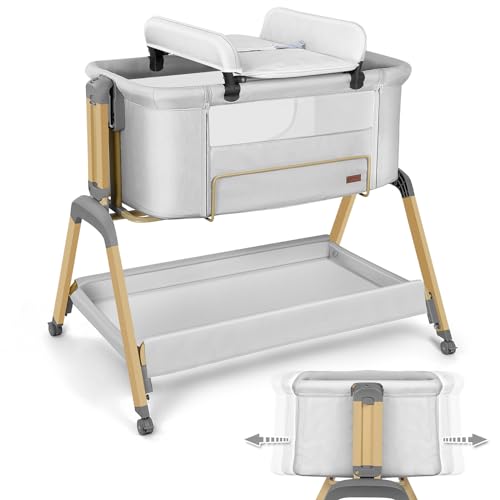10 Ways To Create Your Bedside Cot For New Parents Empire
The Ultimate Guide to Bedside Cots for New Parents
As new parents embark on the exhilarating and in some cases overwhelming journey of raising a kid, one of the vital choices they face is where their baby will sleep. One option that has gained popularity in current years is the bedside cot. Providing convenience, safety, and ease of access, these cots have become a favored option for many parents. This short article digs into the benefits, features, and factors to consider when selecting a bedside cot for new parents.
What is a Bedside Cot?
A bedside cot is developed to connect safely to the side of the parent's bed, enabling for easy access to the baby while offering them with their own sleeping space. These cots usually feature adjustable heights, enabling them to line up with the height of the adult bed, in addition to security features to make sure that the baby remains safe throughout the night.
Advantages of Using a Bedside Cot
- Reduce of Access: New parents can quickly pick up or relieve their baby throughout nighttime feedings without requiring to rise.
- Lowered Risk of SIDS: Being able to keep an eye on the baby carefully while they sleep can minimize some concerns surrounding Sudden Infant Death Syndrome (SIDS).
- Promotes Bonding: The distance to the baby enables more moments of bonding, making it easier for parents to respond to their kid's requirements.
- Co-sleeping Safety: Bedside cots enable for the advantages of co-sleeping while keeping a safe sleeping environment for the infant.
- Space-Saving: These cots can fit comfortably beside adult beds, making them a convenient alternative for smaller spaces.
Key Features to Consider
When selecting a bedside cot, it is necessary to assess different features to make sure that it satisfies your requirements and those of your baby. Below is a helpful table describing crucial features to think about:
Feature
Description
Height Adjustability
Ability to adjust the cot to align with parent bed height.
Protect Attachment
Mechanism to connect the cot firmly to the adult bed.
Safety Standards
Compliance with security policies and certifications.
Storage Space
Under-cot storage to arrange baby fundamentals.
Mobility
Light-weight and easy to transport for travel purposes.
Mattress Quality
Non-toxic and breathable mattress for baby's convenience.
Reduce of Setup
Simple assembly and disassembly procedure.
Types of Bedside Cots
Picking the right type of bedside cot can significantly affect its use and performance for new parents. Here are some typical types:
- Traditional Bedside Cots: These are basic cots installed on wheels or a stable base that can be firmly connected to the moms and dad's bed.
- Co-sleepers: Cots created specifically for co-sleeping enable for easy access and usually have detachable sides.
- Convertible Cots: These versatile cots can transition into a routine crib or young child bed as your child grows.
- Portable Cots: Lightweight and collapsible, they are ideal for travel while still enabling for close contact with the baby.
Selecting the Right Bedside Cot
With numerous options available in the market, picking the ideal bedside cot can seem difficult. New parents should consider the list below elements:
Space Requirements: Measure the readily available space beside the bed to guarantee the cot will fit without taking control of the room.
Spending plan: Bedside cots vary in rates. Figure out a spending plan and choose a cot that fits within your monetary constraints, keeping in mind that quality and security should not be compromised.
Material & & Design: Consider the products used, guaranteeing they are non-toxic and safe for babies. The design needs to likewise complement the home decoration.
Reduce of Cleaning: Babies can be unpleasant, so go with cots that have removable and washable materials or easy-to-clean surfaces.
User Reviews: Reading evaluations from other parents can provide valuable insights into the performance and security of the cot.
Frequently Asked Questions (FAQs)
1. What is the recommended age for utilizing a bedside cot?
A lot of bedside cots are ideal for infants from birth up to around 6 months, but this differs depending on the specific design and design. Always describe the manufacturer's standards.
2. Are bedside cots safe for newborns?
Yes, as long as the cot meets security requirements, is properly attached to the parent's bed, and is used according to the maker's instructions.
3. Can I use a regular crib as a bedside cot?
Regular cribs are typically not created for bedside use, as they do not attach safely to beds. Bedside Cot For Versatile Use to use a cot particularly designed for this function.
4. How do I make sure the bedside cot does stagnate throughout use?
Always examine that the attachment system is securely attached to the bed and think about utilizing anti-slip pads for included stability.
5. How do I choose the best bed mattress for a bedside cot?
Look for a company, breathable bed mattress developed for infants that fulfills safety standards and fits snugly within the cot without gaps.
Bedside cots use a practical solution for new parents, providing convenience, safety, and the capability to bond carefully with their newborns. With different designs and functions readily available, parents should carefully examine their individual requirements and choices to make an informed choice. Eventually, picking a top quality bedside cot can enhance the early parenting experience, making sure both the baby's security and the parents' comfort.
